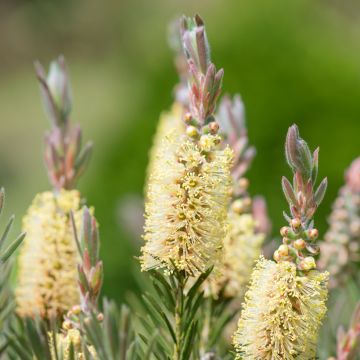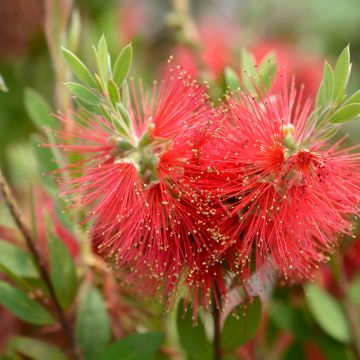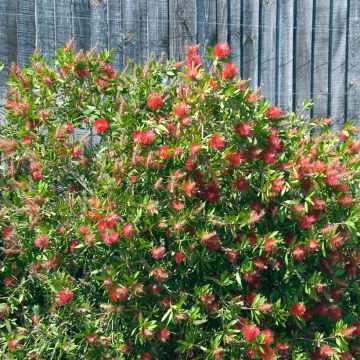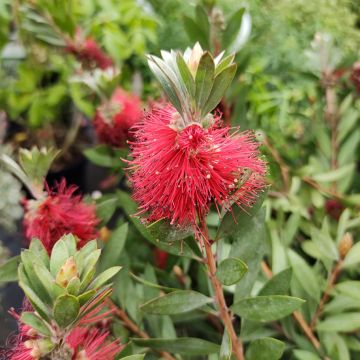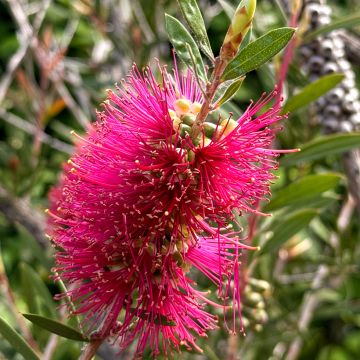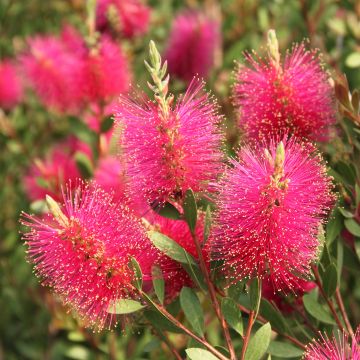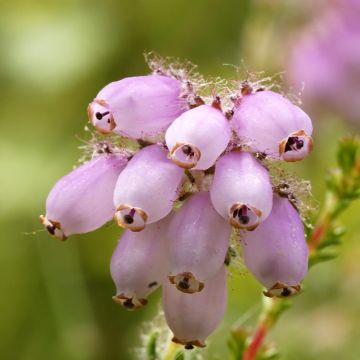

Callistemon Red rocket - Rince bouteille
Callistemon citrinus Red Rocket - Bottlebrush
Callistemon x citrinus Red rocket
Crimson Bottlebrush, Red Bottlebrush, Lemon Bottlebrush
Excellent condition young plant, of beautiful pruning. Always so satisfied with the deliveries and top-notch packaging!
Bertine, 01/12/2023
Special offer!
Receive a €20 voucher for any order over €90 (excluding delivery costs, credit notes, and plastic-free options)!
1- Add your favorite plants to your cart.
2- Once you have reached €90, confirm your order (you can even choose the delivery date!).
3- As soon as your order is shipped, you will receive an email containing your voucher code, valid for 3 months (90 days).
Your voucher is unique and can only be used once, for any order with a minimum value of €20, excluding delivery costs.
Can be combined with other current offers, non-divisible and non-refundable.
Home or relay delivery (depending on size and destination)
Schedule delivery date,
and select date in basket
This plant carries a 24 months recovery warranty
More information
We guarantee the quality of our plants for a full growing cycle, and will replace at our expense any plant that fails to recover under normal climatic and planting conditions.

Would this plant suit my garden?
Set up your Plantfit profile →
Description
Callistemon citrinus 'Red Rocket' is a beautiful hybrid with a compact habit that stands out for its particularly colourful growth. This bush, suitable for mild climates, will charm with its shiny young shoots, almost as decorative as its dazzling flowering in bright red bottlebrushes. Its evergreen and leathery foliage emits a scent that curiously resembles that of the Lemon-scented Eucalyptus, its cousin in the myrtle family. Its modest size, attractive dense habit, and year-round foliage make it an excellent patio plant in all regions. It will shine in the center of an exotic bed in a seaside garden.
Callistemon 'Red Rocket' is an evergreen bush in the myrtle family, a cousin of myrtles and Leptospermum. This 'Red Rocket' variety is the result of cross-breeding with Callistemon citrinus, native to Australia. Most Callistemons are riverside plants that appreciate fresh, well-drained soils, without excess limestone, and can even tolerate dry conditions in summer. Regular and generous watering supports their flowering. The species name citrinus refers to the particular scent of its foliage.
Callistemon 'Red Rocket' forms a dense bush that will not exceed 1.50m (4ft 11in) in height and 1m (3ft 4in) in width. It is a bush suitable for mild climates and does not tolerate frost below -5°C (23 °F) well. Its linear and narrow foliage is divided into leaflets that are 5cm (2in) long and 1.3cm (0.5in) wide. They are tinted scarlet red when they emerge, then become light green and finally dark green. The young leaves produced in late summer retain their red colour throughout the winter. Flowering occurs from May to July-August, depending on the climate. The inflorescences appear at the tips of the branches, just above the young leaves. They consist of very long bright red stamens, which take on a more magenta hue as the days go by and are gathered in cylindrical spikes. These inflorescences are 5cm (2in) wide and about 10cm (3.9in) long. Light pruning after flowering will result in the formation of new shoots, followed by new bottlebrushes. The faded flowers produce small, very hard cup-shaped fruits embedded in the bark. Callistemon 'Red Rocket' is a nectar-rich plant that attracts many pollinating insects in the garden.
Callistemon 'Red Rocket' tolerates summer drought quite well once established, but appreciates water in very dry climates. In a greenhouse or conservatory, it will pair well with a Cape leadwort, a Tibouchina, or a Mimosa, forming an extremely decorative quartet that evokes landscapes with exotic charm and scents. On the Mediterranean coast or in a warm to moderately warm Atlantic climate, it can be used as a standalone plant - it deserves it - in the centre of a bed, or as an informal hedge, combined with Grevillea, Caesalpinia gillesii, Leptospermum, and compact Ceanothus ('Italian Skies', 'Concha', 'Puget Blue', 'Skylark'...). Its good tolerance to salt allows for coastal exposure, facing the wind and sea spray.
Report an error about the product description
Callistemon citrinus Red Rocket - Bottlebrush in pictures
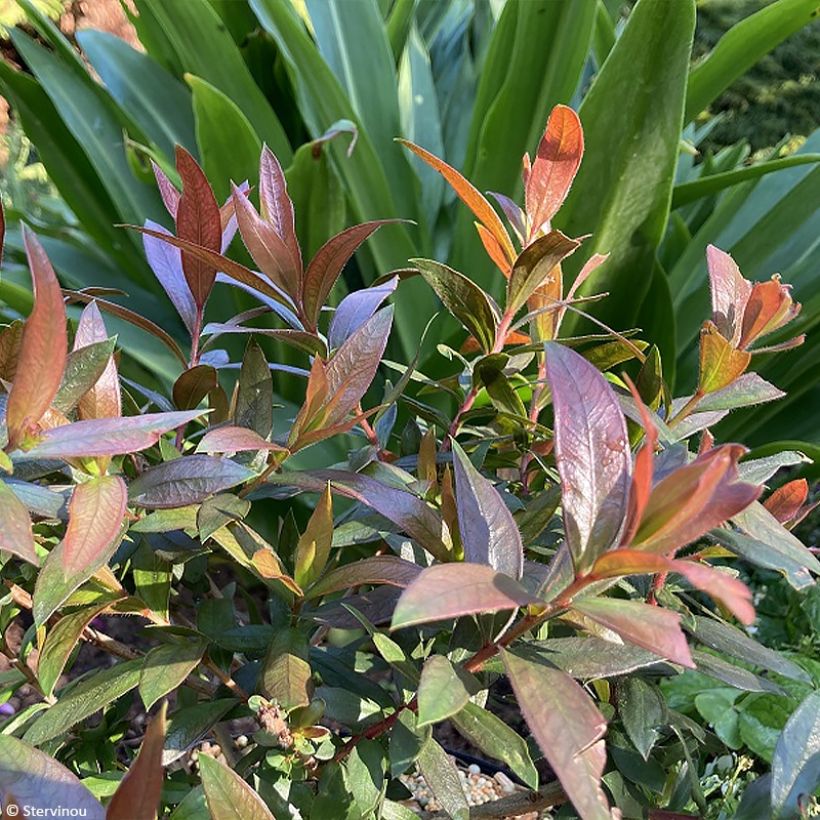

Plant habit
Flowering
Foliage
Botanical data
Callistemon
x citrinus
Red rocket
Myrtaceae
Crimson Bottlebrush, Red Bottlebrush, Lemon Bottlebrush
Cultivar or hybrid
Other Callistemon
View all →Planting and care
Callistemon citrinus 'Red Rocket' is planted in spring or, at a push, early autumn in very mild climates. It will thrive in a light, well-drained, fertile soil that is moist to dry in summer, even though it greatly appreciates regular watering to support its beautiful flowering. Loose soil, whether humus-rich, slightly rocky or sandy, acidic, neutral or slightly alkaline (pH <7.5), will do the trick. If your soil is distinctly alkaline, it is necessary to dig a hole and fill it with a mixture of heather soil, compost, coarse sand, and garden soil. Treat it with an anti-chlorosis product (sequestrant) if you notice abnormal yellowing of the leaves. It tolerates sea spray and drought, although the latter will affect its floribundity. A Callistemon should never show signs of dehydration; if it does, it will struggle to recover. It will thrive in full sun in a warm and sheltered position. Under these conditions, it is hardy down to -5°C (23 °F) and can live for many years. Surround it with winter protection and keep it as insulated as possible from the cold. Place it in the warmest corner of the garden, in full sun against a south-facing wall. In regions further from the sea, it will be necessary to cultivate it in a large pot to be stored away for the winter in a bright, unheated space.
Cultivating in pots:
Ensure good drainage at the bottom of the pot, which should be of large volume. Use a light substrate enriched with leaf compost and apply a slow-release fertilizer in late winter and autumn. Water generously in summer, allowing the soil to dry out a little between waterings. The more you water, the more your Callistemon will flower.
Multiplication by sowing seeds in autumn. They retain their seed viability for 3 years. To release the seeds, which are as fine as dust, from their hard shell, simply pass them quickly over a candle flame, for example. The shells will burst open due to the heat, releasing the seeds. Be sure to place a cloth or piece of paper on your work surface to collect the seeds.
Multiplication by semi-ripe stem cuttings is also possible in autumn or spring.
Planting period
Intended location
Care
-
, onOrder confirmed
Reply from on Promesse de fleurs
Similar products
Haven't found what you were looking for?
Hardiness is the lowest winter temperature a plant can endure without suffering serious damage or even dying. However, hardiness is affected by location (a sheltered area, such as a patio), protection (winter cover) and soil type (hardiness is improved by well-drained soil).

Photo Sharing Terms & Conditions
In order to encourage gardeners to interact and share their experiences, Promesse de fleurs offers various media enabling content to be uploaded onto its Site - in particular via the ‘Photo sharing’ module.
The User agrees to refrain from:
- Posting any content that is illegal, prejudicial, insulting, racist, inciteful to hatred, revisionist, contrary to public decency, that infringes on privacy or on the privacy rights of third parties, in particular the publicity rights of persons and goods, intellectual property rights, or the right to privacy.
- Submitting content on behalf of a third party;
- Impersonate the identity of a third party and/or publish any personal information about a third party;
In general, the User undertakes to refrain from any unethical behaviour.
All Content (in particular text, comments, files, images, photos, videos, creative works, etc.), which may be subject to property or intellectual property rights, image or other private rights, shall remain the property of the User, subject to the limited rights granted by the terms of the licence granted by Promesse de fleurs as stated below. Users are at liberty to publish or not to publish such Content on the Site, notably via the ‘Photo Sharing’ facility, and accept that this Content shall be made public and freely accessible, notably on the Internet.
Users further acknowledge, undertake to have ,and guarantee that they hold all necessary rights and permissions to publish such material on the Site, in particular with regard to the legislation in force pertaining to any privacy, property, intellectual property, image, or contractual rights, or rights of any other nature. By publishing such Content on the Site, Users acknowledge accepting full liability as publishers of the Content within the meaning of the law, and grant Promesse de fleurs, free of charge, an inclusive, worldwide licence for the said Content for the entire duration of its publication, including all reproduction, representation, up/downloading, displaying, performing, transmission, and storage rights.
Users also grant permission for their name to be linked to the Content and accept that this link may not always be made available.
By engaging in posting material, Users consent to their Content becoming automatically accessible on the Internet, in particular on other sites and/or blogs and/or web pages of the Promesse de fleurs site, including in particular social pages and the Promesse de fleurs catalogue.
Users may secure the removal of entrusted content free of charge by issuing a simple request via our contact form.
The flowering period indicated on our website applies to countries and regions located in USDA zone 8 (France, the United Kingdom, Ireland, the Netherlands, etc.)
It will vary according to where you live:
- In zones 9 to 10 (Italy, Spain, Greece, etc.), flowering will occur about 2 to 4 weeks earlier.
- In zones 6 to 7 (Germany, Poland, Slovenia, and lower mountainous regions), flowering will be delayed by 2 to 3 weeks.
- In zone 5 (Central Europe, Scandinavia), blooming will be delayed by 3 to 5 weeks.
In temperate climates, pruning of spring-flowering shrubs (forsythia, spireas, etc.) should be done just after flowering.
Pruning of summer-flowering shrubs (Indian Lilac, Perovskia, etc.) can be done in winter or spring.
In cold regions as well as with frost-sensitive plants, avoid pruning too early when severe frosts may still occur.
The planting period indicated on our website applies to countries and regions located in USDA zone 8 (France, United Kingdom, Ireland, Netherlands).
It will vary according to where you live:
- In Mediterranean zones (Marseille, Madrid, Milan, etc.), autumn and winter are the best planting periods.
- In continental zones (Strasbourg, Munich, Vienna, etc.), delay planting by 2 to 3 weeks in spring and bring it forward by 2 to 4 weeks in autumn.
- In mountainous regions (the Alps, Pyrenees, Carpathians, etc.), it is best to plant in late spring (May-June) or late summer (August-September).
The harvesting period indicated on our website applies to countries and regions in USDA zone 8 (France, England, Ireland, the Netherlands).
In colder areas (Scandinavia, Poland, Austria...) fruit and vegetable harvests are likely to be delayed by 3-4 weeks.
In warmer areas (Italy, Spain, Greece, etc.), harvesting will probably take place earlier, depending on weather conditions.
The sowing periods indicated on our website apply to countries and regions within USDA Zone 8 (France, UK, Ireland, Netherlands).
In colder areas (Scandinavia, Poland, Austria...), delay any outdoor sowing by 3-4 weeks, or sow under glass.
In warmer climes (Italy, Spain, Greece, etc.), bring outdoor sowing forward by a few weeks.































